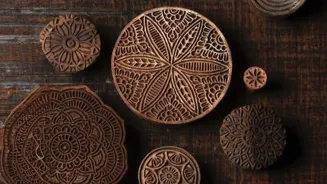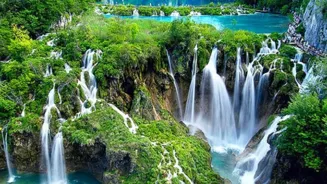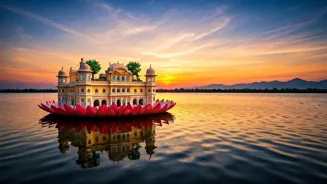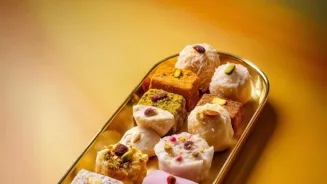Uncover India's Unique Handicrafts: 5 Collectible Gems! Dive into the world of Indian craftsmanship, each piece a cultural treasure waiting to be explored. From Blue Pottery to Madhubani Paintings, Wooden
Toys, Pashmina Shawls, and Dhokra Art, discover the artistry and heritage behind these exquisite creations. Each item tells a story of tradition,
India, a land known for its vibrant culture and rich heritage, also boasts an incredible array of handicrafts. These aren't just pretty objects; they are stories woven in thread, molded in clay, and carved in wood, each reflecting the unique traditions of its region.
Collecting Indian handicrafts is a way to bring a piece of this diverse heritage into your home and support the skilled artisans who keep these age-old traditions alive. So, ditch the mass-produced items and embark on a journey to discover the beauty and artistry of Indian handicrafts.
You’ll find pieces that are not only beautiful but also carry a deep cultural significance, making them truly special additions to any collection.
The world of Indian handicrafts is immense and varied. From intricate textiles to stunning metalwork, it can be overwhelming to know where to start.
This article highlights five unique Indian handicrafts that are perfect for starting or expanding your collection. Each item represents a different region and art form, showcasing the incredible diversity of Indian craftsmanship.
We delve into the history, the techniques used, and what makes each piece truly special. Prepare to be amazed by the skill and dedication that goes into creating these beautiful objects, each a testament to India's artistic legacy.
These items offer a glimpse into the soul of India, offering more than just aesthetic value.
Blue Pottery of Jaipur, Rajasthan:
Imagine pottery that shimmers with shades of blue, turquoise, and white, adorned with delicate floral patterns and geometric designs. That's the magic of Blue Pottery from Jaipur, Rajasthan. Unlike regular pottery, Blue Pottery doesn’t use clay.
It’s made from a unique mixture of quartz powder, powdered glass, borax, gum, and water. This creates a smooth, almost translucent surface that’s perfect for painting.
It’s believed that this art form travelled to India from Persia via the Silk Route and was adopted by Jaipur's artisans in the 18th century. Today, it’s one of the most recognized crafts from Rajasthan.
Each piece of Blue Pottery is carefully handcrafted, from mixing the raw materials to shaping, painting, and firing. The artisans use their hands and simple tools to mold the mixture into various forms, such as vases, plates, bowls, and decorative tiles.
The designs are painted by hand using squirrel-hair brushes, requiring immense skill and precision. The colors are derived from natural sources, with cobalt oxide providing the signature blue hue.
What makes Blue Pottery even more special is its resistance to cracking and its suitability for everyday use. A Blue Pottery vase filled with flowers, a set of bowls adding charm to your kitchen, or even tiles decorating your walls, can bring a touch of elegance and tradition to your home.
Purchasing Blue Pottery not only adds beauty to your space but also supports the livelihoods of the artisans who keep this ancient craft alive. It is a piece of history you can display in your home.
Madhubani Paintings of Bihar:
Transport yourself to the villages of Bihar with Madhubani paintings, also known as Mithila art. These vibrant paintings are characterized by their bold lines, bright colors, and intricate patterns.
Traditionally created by women on the walls of their homes, these paintings depict scenes from mythology, nature, and everyday life. The art form is believed to have originated centuries ago and was traditionally passed down from mother to daughter.
Natural pigments are used to create the colours, derived from plants, flowers, turmeric, and charcoal. The paintings often feature double lines, giving them a distinct and eye-catching look.
Madhubani paintings are more than just decorations; they are visual narratives that tell stories and convey cultural values. Common themes include depictions of Hindu deities like Krishna, Rama, and Durga, as well as scenes from local festivals and rituals.
Animals, birds, and floral motifs are also frequently incorporated, reflecting the close connection between the people and their environment. The use of geometric patterns adds another layer of complexity and symbolism to the art.
Owning a Madhubani painting means owning a piece of Bihar’s cultural heritage. Hang it on your wall, and you'll not only have a beautiful piece of art but also a conversation starter that tells a story of tradition, community, and the artistic spirit of rural India.
Each painting is a unique expression of the artist's creativity and connection to her roots.
Wooden Toys of Channapatna, Karnataka:
Step into a world of colorful and charming toys with the Wooden Toys of Channapatna, Karnataka. These toys are known for their bright colours, smooth finish, and intricate designs. Made from soft ivory wood, the toys are hand-carved and painted with natural dyes, making them safe and eco-friendly.
The tradition of toy-making in Channapatna dates back to the reign of Tipu Sultan in the 18th century. He invited Persian artisans to teach the local craftsmen the art of woodworking, and since then, Channapatna has become a hub for wooden toy manufacturing.
From dolls and animals to puzzles and miniature furniture, the range of Wooden Toys from Channapatna is vast and appealing. The artisans use traditional techniques and tools to shape and carve the wood, showcasing their skill and craftsmanship.
The toys are then painted with vibrant colours using natural dyes derived from vegetables, fruits, and other organic sources. This ensures that the toys are safe for children and environmentally friendly.
Collecting Wooden Toys from Channapatna is a wonderful way to support sustainable practices and preserve a traditional craft. These toys aren't just for children; their beauty and craftsmanship make them delightful decorative items for adults as well.
They add a touch of nostalgia and charm to any space, reminding you of simpler times and the joy of handmade creations.
Each piece is crafted with precision and care, making them durable and long-lasting.
Pashmina Shawls of Kashmir:
Wrap yourself in luxury and warmth with a Pashmina Shawl from Kashmir. These shawls are renowned for their softness, fineness, and exquisite craftsmanship. Pashmina is derived from the fleece of Changthangi goats, a special breed found in the high altitudes of the Himalayas.
The wool is incredibly fine and soft, making it ideal for creating luxurious shawls, scarves, and wraps. The art of weaving Pashmina shawls in Kashmir dates back centuries, and it's a closely guarded tradition passed down through generations.
Each Pashmina shawl is hand-woven by skilled artisans using traditional looms. The process is time-consuming and requires immense patience and expertise. The shawls are often embellished with intricate embroidery, adding to their beauty and value.
From simple designs to elaborate patterns, the embroidery is done by hand, making each shawl a unique work of art. A Pashmina shawl is more than just a piece of clothing; it's a symbol of elegance, sophistication, and timeless style. It’s an investment that you can cherish for years to come.
Whether you wear it to keep warm on a chilly evening or drape it over your shoulders for a special occasion, a Pashmina shawl will always make you feel luxurious and pampered.
Owning a Pashmina shawl also supports the livelihoods of the artisans in Kashmir who are dedicated to preserving this traditional craft.
Dhokra Art from Chhattisgarh & West Bengal:
Discover the rustic beauty of Dhokra Art, an ancient metal casting technique practiced in the states of Chhattisgarh and West Bengal.
This art form uses the "lost wax casting" technique, an age-old method that involves creating a clay mold, covering it with wax threads, and then replacing the wax with molten metal. The resulting metal figures are unique and characterized by their intricate details and tribal motifs.
Dhokra art is believed to be one of the earliest forms of metal casting known to humankind, with evidence dating back over 4,000 years.
Dhokra Art pieces often depict scenes from tribal life, including village rituals, animals, and deities.
The figurines are typically made of brass or bronze and have a distinctive, slightly rough texture that adds to their charm. From tribal figures and animals to lamps and decorative items, Dhokra art is versatile and captivating.
Each piece is handcrafted, making it a unique and valuable addition to any collection. The process requires skill, patience, and a deep understanding of the materials and techniques involved. Collecting Dhokra Art means owning a piece of India's tribal heritage.
These pieces are not only beautiful but also serve as a reminder of the country's rich cultural diversity and the artistic traditions of its indigenous communities.
They make wonderful conversation pieces and can add a touch of rustic elegance to any décor.













